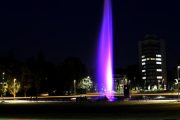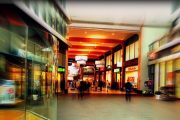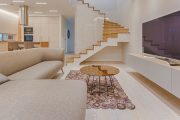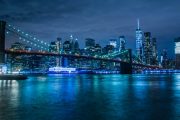Characteristics of Campus Night Lighting
Campuses are mostly relatively independent special community environments, which not only have the characteristics of urban communities and urban residential areas, but also have elements that are different from ordinary urban environments. Campus night lighting should strive to be solemn and concise, light and bright, and not as glamorous as commercial districts or leisure and entertainment venues, emphasizing rendering its prosperous and splendid atmosphere.
- Focus on the environment and context.
The campus night scene lighting must exist depending on the campus environment. The connotation of environment here includes social, cultural, time, historical, psychological and other elements. - Utilize resources for night scene lighting.
In campus buildings, the interiors are mostly divided by large bays. In order to create good lighting and ventilation conditions, the window area is large. The indoor space utilization rate is high, the use time is long, the indoor lighting requirements are efficient and clear, and the illuminance is sufficient. Therefore, there is no need to install special internal light-transmitting lighting equipment, and the lighting required for indoor functions is used as the lighting source of the building night scene as much as possible. Let the indoor light shine outward, and use a large number of windows to form a bright luminous surface to decorate the night view of the building, making the landscape unique and full of life. - Highlight the key points and strengthen the display.
The campus night scene lighting can adopt diversified schemes flexibly, emphasizing the characteristics of the building and important areas, and deliberately creating the night atmosphere of the campus. By fully dissecting the functions, characteristics, and styles of the illuminated objects, thoroughly understanding the specific role of light and shadow and the environment, simulating the night scene state of various viewpoints and visual distances, and strengthening the visual perception of the building and the environment. Enrich the building’s shape with the aid of night scene lighting on the performance or exaggeration of the uneven changes of the building.
- Respect nature and add vitality to the environment.
The night lighting design of the campus garden is an integral part of the campus environment design. The garden lighting shows the tenderness and broadness of the green grass in the night through the changes of the brightness and color of the light, reveals the vividness of the magnificent flowers, edits the richness and shadow of the trees, and calmly connects the building and the campus, the campus and the nature, and the nature and the people.
Lighting Design Method
Illuminance
Different functions and different illuminances form a reasonable level of light and dark
In order to form a night campus environment that is conducive to learning, scientific research, academic exchanges, and comfortable rest, campus night lighting should highlight the key points in the distribution of light and shade, and constitute a reasonable level.
High-intensity lighting should be applied to the main passages, school gates, entrances and exits of important buildings and other areas of the school to form a prominent and eye-catching lighting effect, and the illuminance value can even reach 100lx.
In general avenues, squares and other large areas of people in the school, medium-intensity lighting should be applied, requiring 50-75lx of illumination; lakesides, lawns, trails, green belts and other strolling leisure areas, the illumination should not be too high, generally 8~ 15lx.
The entrances and exits of dormitories, libraries, teaching buildings, activity centers, student clubs and other places where students frequently enter and exit should also have relatively strong uniform illumination, generally 30-50lx.
Light Color
Illumination light color is mainly cool color, supplemented by warm color
In order to adapt to the humanistic and social characteristics of the campus environment, the light and color design of campus lighting must be harmonious and calm. The specific color tone is based on a large area of cool color, and a specific small range of warm color is supplemented.
As for the lighting tones of different functional areas, the design should be treated differently.
High-brightness lighting areas such as school gates, important passages, entrances and exits of important buildings should be both cold and warm, with the necessary visual warmth effect, to prevent excessive cold treatment, forming a gloomy and fearful visual impression.
It is not advisable to use too many warm and cheerful colors around general buildings and laboratories. A quiet and peaceful lighting atmosphere should be formed to suit the work and study environment of reading, thinking, and meditation.
Classroom Lighting Method
It is necessary to comprehensively consider the observation angle of students and teachers to avoid glare.
Classroom lighting method and control
The lighting principle of the classroom: According to the teaching function, the classroom is divided into a podium teaching area and a student seating area. The long axis of the lamps is perpendicular to the blackboard, arranged in 3 columns, 4 sets in each column, and the distance between the lamps meets the requirement of uniformity of illumination. Moreover, this arrangement makes it easier to guide the students’ sight and focus on the podium area.
The lamps provide a variety of installation methods, including embedded, ceiling-mounted, and suspended. The setting of the blackboard lamp position needs to consider the observation angle of students and teachers comprehensively to avoid direct glare and reflected glare from affecting them. Dedicated blackboard light can adjust the direction of illumination. It is recommended to be 0.3~0.6 meters away from the wall.
Selection of light source
Ordinary classrooms choose 2X36W double-tube matte grid fluorescent lamps with an efficiency of 72%. This type of lamp has not only downward light but also a small amount of upward light. This part of the uplight has two functions: on the one hand, it illuminates the ceiling, making the entire indoor space appear tall, spacious and bright, and it is easy to achieve the effect of the sky in daylight lighting. On the other hand, light shines on the ceiling and reaches the ground through the secondary reflection of the high-reflectivity ceiling, which increases the diffused light in the space and improves the comfort of lighting, especially in the process of multimedia reading.
Studies have shown that under the same 300lx illuminance level, a 10% increase in diffused light illumination is 1.5 times more enjoyable than a pure direct light illumination environment.
Library Lighting Design Standard
Minimize the brightness ratio of writing and background
Library lighting is generally divided into visual task lighting and ambient lighting. Library lighting must meet the requirements of searching for books and reading, and has strong functionality; at the same time, good library lighting, like general classroom lighting, must also have certain auxiliary functions, that is, reduce visual fatigue, concentrate attention, etc. . In order to facilitate the search for books, it is necessary to consider the illuminance of the spatial elevation.
The book reading room should be designed according to 200-750lx illuminance. At the same time, it is required to avoid the shadow caused by diffused light. The light should be sufficient, but there should be no glare. The brightness ratio of the writing and the background should be minimized.
There have been professional evaluation standards for the comfort of lighting in the world. According to this, in the design process, we follow the steps below to carry out detailed lighting design work:
1) Determine the illuminance level and spatial brightness distribution of each subdivision area.
2) According to the architectural features and function distribution, configure the color temperature of the lighting in the space.
3) The color rendering of the light source is required to be greater than 80.
4) Choose lamps according to lighting needs, and compare and optimize the design of lamps and lanterns, and comprehensively realize the values recommended in the standard.
5) Energy saving: use high-efficiency and energy-saving lighting fixtures; use high-efficiency and energy-saving electric light sources; configure high-quality electronic ballasts to overcome flicker and improve light source efficiency; zone lighting control, etc.
6) Environmental coordination: including light and color coordination, illuminance coordination, and the illuminance change of adjacent areas with different functions should not exceed 5:1.








